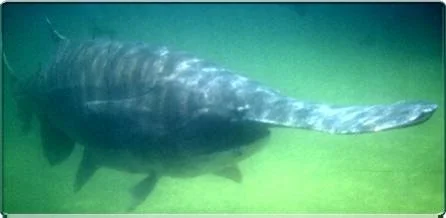On clear, dark nights the Kansas City skyline bounces off the Missouri River. On the surface, the Big Muddy is boring. It's not wide like the Mississippi and it's not wild like the Yukon. Underwater is a different story. Ancient giants swim here.
Smiling or not depends on your persepective I guess. Photo courtsey of the United States Fish and Wildlife Service
The first time I saw a paddlefish in person I thought the fish was smiling at me. It wasn't happy to see me in reality. It was happily gorging on plankton just like every other paddlefish for the last 165 million years. In proper biological terms, paddlefish are filter feeders. That means they swim forward forcing water over its gills. They breath through their gills and collect food via gill rakers.
These fish can grow over seven feet long and weigh about 200 pounds. The fish look like grey ships floating through the water column. For us humans, they are like a pleasant sail ship. For microorganisms, paddlefish are like aircraft carriers armed to the teeth. From above, their rostrum, the "paddle" part of paddlefish you can see in front of their faces, even looks like a runway. The rostrum helps them navigate the dark water and find food. It has millions of tiny sensors called ampullae of Lorenzini that detect electric signals from the plankton. Shovelnose Catfish as they're sometimes called swing the rostrum around like a radar in search of the next meal.
Paddlefish swim up and down the Missouri drawing attention like carriers on the open ocean. The river was always big and slow-flowing. It was notorious with sailors in the 19th century for being different every single day. It was as inconsistently consistent as the weather in Kansas City. That river was perfect for paddlefish. The silty water was loaded with food. Paddlefish had all the tasty plankton (the freshwater kind not the krabbie patty stealing kind).
A paddlefish lurking in the dark. Photo courtsey of the United States Fish and Wildlife Service


